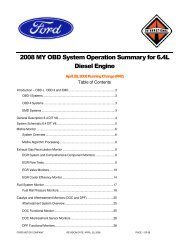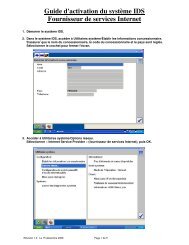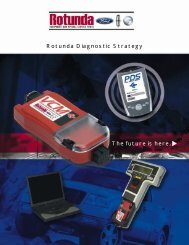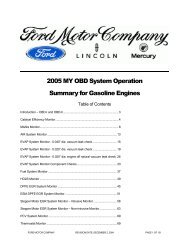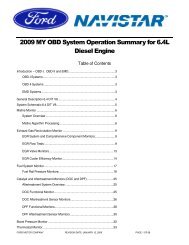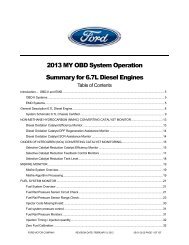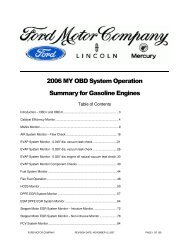2002 MY OBD-II System Operation Summary - MotorCraftService.com
2002 MY OBD-II System Operation Summary - MotorCraftService.com
2002 MY OBD-II System Operation Summary - MotorCraftService.com
You also want an ePaper? Increase the reach of your titles
YUMPU automatically turns print PDFs into web optimized ePapers that Google loves.
The ECT warm-up time is also monitored. If ECT fails to reach a minimum temperature (140 o F) within a specifiedtime period, an “insufficient temp for closed loop” malfunction is indicated (P0125). (See Thermostat monitoringsection.)MiscellaneousLoss of Keep Alive Memory (KAM) power (a separate wire feeding the PCM) results is a P1633 DTC andimmediate MIL illumination on most applications. (Some 2000 <strong>MY</strong> applications require 2 driving cycles.)Vehicles that require tire/axle information to be programmed into the Vehicle ID block (VID) will store a P1639 if theVID block is not programmed or corrupted.IgnitionDistributor Ignition systems (TFI) are no longer in production. Electronic Ignition systems (Electronic DistributorlessIgnition <strong>System</strong> - EDIS or Coil on Plug - COP) systems are being used on all applications.The EDIS system uses a chip to process the 36 (or 40) tooth crankshaft position signal, generate a low data ratePIP signal for the PCM microprocessor and control a 4 or 6 terminal coil pack which fires a pair of spark plugs. Oneof these sparkplugs is on the <strong>com</strong>pression stroke, while the other is on the exhaust stroke. The EDIS chip can beincorporated within the PCM or in a separate ignition control module.The COP system also uses an EDIS chip in the same way as described above, however, each sparkplug has it’sown coil which is fired only once on the <strong>com</strong>pression stroke.The ignition system is checked by monitoring three ignition signals during normal vehicle operation:Profile Ignition Pickup (CKP, <strong>com</strong>monly known as PIP), the timing reference signal derived from thecrankshaft 36-tooth wheel and processed by the EDIS chip. PIP is a 50% duty cycle, square wave signalthat has a rising edge at 10 deg BTDC.Camshaft IDentification (CMP, <strong>com</strong>monly known at CID), a signal derived from the camshaft to identify the#1 cylinderIgnition Diagnostic Monitor (IDM), a signal that indicates that the primary side of the coil has fired. Thissignal is received as a digital pulse width signal from the EDIS chip. The EDIS chip determines if thecurrent flow to the ignition coil reaches the required current (typically 5.5 Amps for COP, 3.0 to 4.0 Ampsfor DIS) within a specified time period (typically > 200 microseconds for both COP and DIS). The EDISchip also outputs status information when the engine is not running.First, the relationship between successive PIP events is evaluated to determine whether the PIP signal is rational.Too large a change in 3 successive PIP indicates a missing or noisy PIP signal (P0320). Next, the CMP edgecount is <strong>com</strong>pared to the PIP edge count. If the proper ratio of CMP events to PIP events is not being maintained(for example, 1 CMP edge for every 8 PIP edges for an 8-cylinder engine), it indicates a missing or noisy CMPsignal (P0340). Finally, the relationship between IDM edges and PIP edges is evaluated. If there is not an IDMedge (coil firing) for every PIP edge (<strong>com</strong>manded spark event), the PCM will look for a pattern of failed IDM eventsto determine which ignition coil has failed. If the ignition coil cannot be identified or if the engine is running andthere are no IDM edges, the IDM circuit is malfunctioning (P1351).FORD MOTOR COMPANY REVISION DATE: OCTOBER 02, 2001 PAGE 40 OF 66



